Mundroi
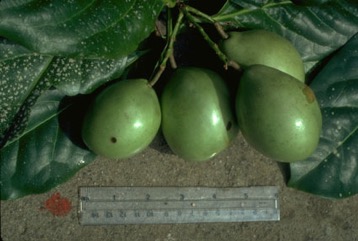
A tropical plant. Trees occur in well drained rainforest, up to 1800 m altitude, in the tropics near the equator. They have been recorded up to 2750 m above sea level. They occur naturally in Australia, Papua New Guinea, and the Solomon Islands. In the Solomon Islands trees have been recorded up to 600 m above sea level.
Also known as:
Ibo, Ibo kwao, Ibo bala, Moso, Nodombu, Nyia nwadabu, Pohon kayu pondok, Putsakuleo, Tebu, Tembu
Synonyms
- Corynocarpus australasica C.T. White
- Cyanocarpus cribbiana F.M. Bail.
- Helicia cribbiana (F.M. Bail.) F.M. Bail.
Edible Portion
- Fruit
Where does Mundroi grow?
Found in: Asia, Australia, Indonesia, Pacific, Papua New Guinea, PNG, SE Asia, Solomon Islands
Notes: There are 4-6 Corynocarpus species. Mundroi Corynocarpus cribbianus What is Mundroi ? Mundroi is the name used on Manus Island for the fruit of a tree that scientists call Corynocarpus cribbianus. The first botanist to describe the tree was F.M.Bailey in Queensland in 1897, but the name was changed a couple of times until in 1956 Corynocarpus cribbianus was decided as the correct scientific name. There are only 4 species of trees in this group of plants called Corynocarpus. And the group is not closely similar to other plants so scientists are still trying to work out how it is related to other groups of plants. One of the other species, Corynocarpus laevigata, is called karaka in New Zealand, and the flesh of the fruit is eaten raw, and the kernel is soaked and steamed to remove poison, then eaten, by Maori people. The group of plants called Corynocarpus only occur in an area between New Zealand and New Guinea, including a little bit of Queensland in Northern Australia. What is a Mundroi like? The mundroi tree is quite a large tree up to 20 metres high. The fruit are produced in clusters at the ends of the branches and are shaped something like a mango. The fruit are smooth on the outside and green when ripe. There are two different kinds of fruit which vary on the colour of the ripe fruit. One kind turns a reddish pink when ripe while the other kind turns a creamy white. This second kind has the larger fruit. The fruit grows up to 10 or 12 cm long and 6-8 cm across. Inside there is one large seed, and the flesh around the seed is eaten. The fruit is only eaten when fully ripe and it is harvested after it has fallen from the tree. The fruit is eaten either raw or cooked. The flesh of the fruit is sweet but not juicy. The mundroi tree has leaves which are dark green on top and pale green underneath. They have veins which join in loops. The veins are raised on the underneath side of the leaf. Mundroi trees are normally planted. They are grown from seed. The similar karaka tree in New Zealand will grow from cuttings, so it would be worth trying this with mundroi. The botanist Van Steenis in his article on this family of plants shows a picture of a flowering plant like this. The flowers have a sweet smell and the petals are white with slightly red tips.
Status: This is a quite important fruit in Papua New Guinea on Manus and on islands near Madang.
Growing Mundroi
Cultivation: Trees are grown from seed.
Edible Uses: The fruit are edible. They are sweet but not juicy. Fruit can be eaten raw or cooked.
Production: The tree flowers and fruits throughout the year. The fruit fall when ripe, and are then collected from the ground. (It is important to only use fruit which fall naturally)
Nutrition Info
per 100g edible portion| Edible Part | Energy (kcal) | Protein (g) | Iron (mg) | Vitamin A (ug) | Vitamin c (mg) | Zinc (mg) | % Water |
|---|---|---|---|---|---|---|---|
| - | - | - | - | - | - |
Mundroi Photos

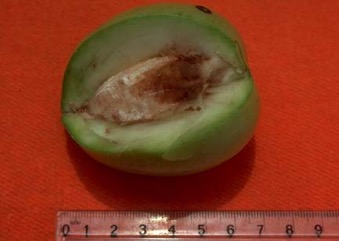
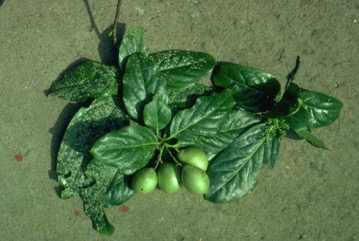
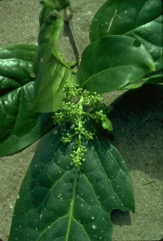
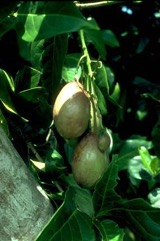
References
Mundroi references Corynocarpus cribbianus
Bailey, F.M., 1897, Cyanocarpus cribbiana in Queensland Agr, J. 1:370
Bailey,F.M., 1901, Helicia cribbiana In Queens Fl 4:1327
Balgooy, M.M.J. van, 1966, Corynocarpus in Blumea Supplement V p110-111.
Cooper, W. and Cooper, W., 2004, Fruits of the Australian Tropical Rainforest. Nokomis Editions, Victoria, Australia. p 139
Elliot, W.R., & Jones, D.L., 1984, Encyclopedia of Australian Plants suitable for cultivation. Vol 3. Lothian. p 102
Flora Malesiana Vol 13 p 263
Foreman, D.B., in Womersley, J.S.,(ed), 1978, Handbooks of the Flora of Papua New Guinea. MUP,Victoria. Vol 1, p 111.
French, B.R., 1986, Food Plants of Papua New Guinea, A Compendium. Asia Pacific Science Foundation p 234
French, B.R., 2010, Food Plants of Solomon Islands. A Compendium. Food Plants International Inc. p 232
Hartley, et al, 1973, Lloydia 36(3), p 267
Henderson, C.P. and I.R.Hancock, 1988, A Guide to the Useful Plants of the Solomon Islands. Res. Dept. Min of Ag. & Lands. Honiara, Solomon Islands. p 142 (As Corynocarpus cribbeanus)
Heywood, V.H., Brummitt, R.K., Culham, A., and Seberg, O. 2007, Flowering Plant Families of the World. Royal Botanical Gardens, Kew. p 113
Kunkel, Corynocarpaceae, the karaka family. p 282
Lepofsky, D., 1992, Arboriculture in the Mussau Islands, Bismarck Archipelago. Economic Botany, Vol 46, No. 2, pp. 192-211
Merrill and Perry, 1941, J.Arn. Arb. 22:541.
Morley, B.D., & Toelken, H.R., (Eds), 1983, Flowering Plants in Australia. Rigby. p 225
Sleumer, 1955, Blumea 8:15
Smith,L.S., 1956, Proc.R.Soc Queensl. 67:31
Steenis, van C.G.G.J., 1933, Bull, J.B.B. 3, 13:101
Steenis, van C.G.G.J., 1947, J.Arn Arb. 28:421
Steenis, van C.G.G.J.,1951, Fl.Mal. 1, 4:263
Sukarya, D. G., (Ed.) 2013, 3,500 Plant Species of the Botanic Gardens of Indonesia. LIPI p 211
Townsend, K., 1994, Across the Top. Gardening with Australian Plants in the tropics. Society for Growing Australian Plants, Townsville Branch Inc. p 140
Walter, A. & Sam C., 2002, Fruits of Oceania. ACIAR Monograph No. 85. Canberra. p 279
White, .., 1933, Corynocarpus australasica Contr. Arn Arb. 4,57,t 5
Yen,D.E., 1974, Arboriculture in the Subsistence of Santa Cruz, Solomon Islands. Econ.Bot. 28:247-281